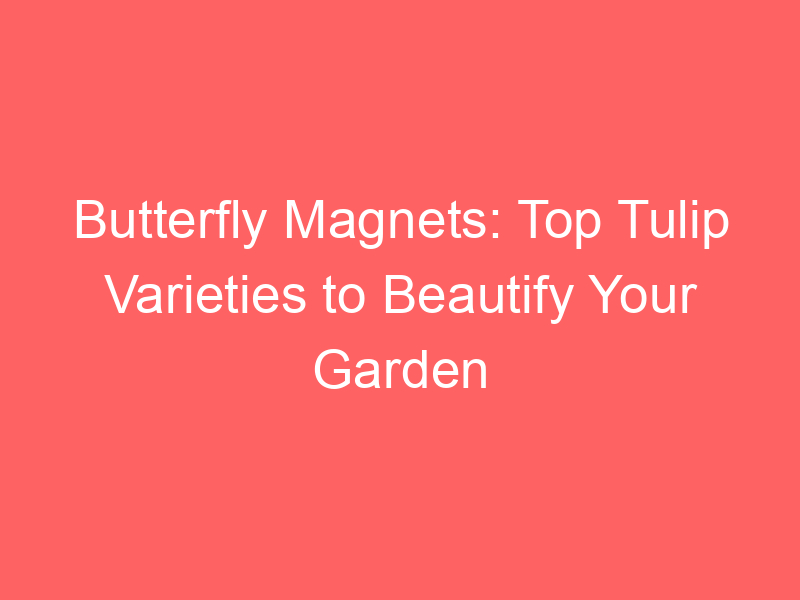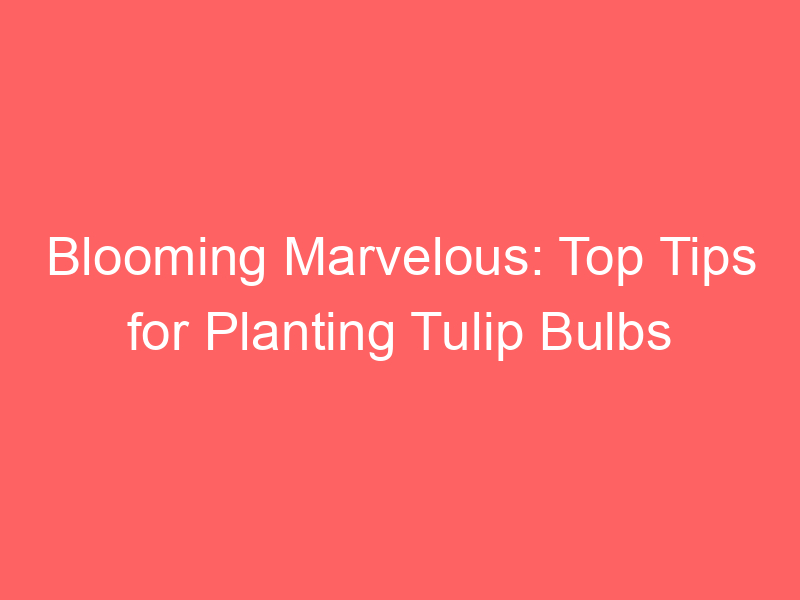Introduction to Butterfly-Friendly Tulips
When it comes to creating a vibrant and lively garden, few things are as enchanting as tulips that attract butterflies. These beautiful flowers not only add a splash of color to your garden, but also play a crucial role in attracting these winged beauties. Let’s delve into the importance of tulips in attracting butterflies and the benefits of having butterflies in your garden.
-
- Importance of tulips in attracting butterflies
Tulips, with their vibrant colors and sweet nectar, are like magnets for butterflies. Butterflies are attracted to bright colors and sweet scents, and tulips provide both. The nectar of tulips provides essential nutrients for butterflies, helping them to thrive and reproduce. Moreover, the presence of butterflies can be a sign of a healthy ecosystem as they are sensitive to environmental changes. Tulips are not only beautiful to look at, but they also play an important role in our environment by attracting these beneficial insects.
-
- Benefits of having butterflies in your garden
Butterflies are more than just beautiful creatures; they offer a variety of benefits for your garden. They act as pollinators, transferring pollen from one flower to another, which helps in the reproduction of plants. This process is crucial for the survival of many plant species and for food production. Furthermore, butterflies can also act as natural pest controllers, as their larvae feed on common garden pests. Having butterflies in your garden not only enhances its beauty but also contributes to biodiversity and the health of the ecosystem.
Butterfly-friendly tulips are a wonderful addition to any garden. They attract butterflies, which in turn help in pollination and pest control. So, if you’re a tulip lover and want to make your garden a haven for butterflies, consider planting some butterfly-friendly tulips. Stay tuned for our next sections where we will discuss the top tulip species for butterflies and provide tips on tulip gardening for butterflies.
Top Tulip Species for Butterflies
Among the numerous species of tulips, some are particularly loved by butterflies. Let’s delve into one such variety – the Single Early Tulips.
Single Early Tulips
Single Early Tulips are one of the most popular and butterfly-friendly species of tulips. They are known for their vibrant colors and early blooming period.
-
- Description and features
Single Early Tulips are characterized by their large, cup-shaped flowers and sturdy stems. They bloom in early spring, adding a splash of color to your garden when most other plants are still dormant. These tulips come in a variety of colors, including red, yellow, pink, and white. Their height typically ranges from 10 to 16 inches, making them a great choice for both garden beds and containers.
-
- Why they attract butterflies
Butterflies are attracted to Single Early Tulips for several reasons. Firstly, their bright colors act as a beacon for butterflies, drawing them in from afar. Secondly, these tulips bloom early in the season, providing a valuable source of nectar when few other flowers are available. Lastly, the shape of the tulip flower makes it easy for butterflies to land and feed. The combination of these factors makes Single Early Tulips a favorite among butterfly species.
Single Early Tulips are not only a beautiful addition to your garden but also a butterfly magnet. Planting them in your garden will not only enhance its beauty but also contribute to the local butterfly population.
Double Early Tulips
Double Early Tulips are a unique and beautiful variety of tulips that are loved by many tulip enthusiasts. Let’s explore more about these captivating flowers.
-
- Description and features
Double Early Tulips, as the name suggests, are known for their double set of petals. They are often compared to peonies or roses due to their full, rounded shape. These tulips typically bloom in early to mid-spring, providing a burst of color after a long winter. The flowers come in a wide range of colors, including red, pink, yellow, and white. They grow to about 10-14 inches tall, making them a perfect addition to any garden. Wikipedia provides more detailed information about these tulips.
-
- Why they attract butterflies
Butterflies are drawn to Double Early Tulips for several reasons. Firstly, the vibrant colors of these tulips are highly attractive to butterflies. Secondly, the double set of petals provides a larger landing platform for butterflies, making these flowers an ideal feeding spot. Lastly, Double Early Tulips produce a sweet nectar that serves as a food source for butterflies. So, planting these tulips in your garden not only adds beauty but also invites these lovely creatures.
Double Early Tulips are not only aesthetically pleasing but also serve a functional role in attracting butterflies. Their vibrant colors, double set of petals, and sweet nectar make them a favorite among these winged beauties. So, if you’re a tulip lover and a butterfly enthusiast, these tulips are a must-have in your garden.
Triumph Tulips
-
- Description and Features
Triumph Tulips are a popular choice among tulip lovers due to their unique characteristics. They are a hybrid of the Single Early and Double Late Tulips, combining the best features of both. Triumph Tulips are known for their sturdy stems, which can withstand harsh weather conditions, and their large, traditional tulip-shaped flowers. They bloom in mid-spring and come in a wide array of colors, making them a vibrant addition to any garden.
| Feature | Description |
|---|---|
| Height | 12-16 inches |
| Bloom Time | Mid-Spring |
| Colors | Various |
| Stem Strength | Strong |
-
- Why They Attract Butterflies
Butterflies are attracted to Triumph Tulips for a few key reasons. Firstly, their bright colors are easily spotted by butterflies, drawing them in. Secondly, Triumph Tulips produce a mild fragrance that is appealing to butterflies. Lastly, these tulips provide a rich source of nectar, which is a primary food source for butterflies. Planting Triumph Tulips in your garden can significantly increase butterfly visits, enhancing the beauty and vitality of your outdoor space.
According to a study, butterflies are more likely to visit gardens with a variety of flower types, including Triumph Tulips. This is because different butterfly species have different preferences when it comes to nectar. By including Triumph Tulips in your garden, you can attract a wider variety of butterflies.
Tulip Gardening for Butterflies
Creating a butterfly-friendly garden with tulips is a rewarding endeavor. It not only enhances the beauty of your garden but also contributes to the ecosystem by providing a habitat for butterflies. The first step in this process is choosing the right location for your tulip garden.
Choosing the Right Location
The location of your tulip garden plays a crucial role in attracting butterflies. There are two key factors to consider when selecting the location: sunlight and wind direction.
-
- Importance of sunlight
Butterflies are cold-blooded creatures and they rely on the sun to warm up their bodies for flight. Therefore, a sunny location is ideal for your tulip garden. Moreover, tulips also need at least 6 hours of direct sunlight each day to bloom properly. So, a sunny spot will benefit both your tulips and the butterflies.
-
- Considering wind direction
Butterflies prefer areas that are protected from strong winds. Windy conditions make it difficult for them to fly and feed on nectar. Therefore, choose a location that is shielded from prevailing winds. This could be a spot near a wall, hedge, or a row of trees. It will provide a safe and comfortable environment for butterflies to linger in your tulip garden.
Selecting the right location for your tulip garden is a critical step in making it butterfly-friendly. A sunny, wind-protected spot will not only help your tulips thrive but also attract a variety of butterflies, adding to the charm and ecological value of your garden.
Planting and Care
Planting and caring for tulips is a rewarding process that requires a little knowledge and effort. Let’s dive into the specifics of when and how to plant tulips, as well as watering and fertilizing tips.
-
- When and how to plant tulips
Tulips are best planted in the fall, around 6 to 8 weeks before a hard frost is expected. This gives them enough time to root before winter. When planting, choose a location with full or afternoon sun and well-draining soil. Dig a hole about three times as deep as the bulb is tall. Place the bulb in the hole with the pointy end up, then cover with soil and water well.
-
- Watering and fertilizing tips
Tulips need regular watering during their growth and blooming period, which is in the spring. However, avoid overwatering as this can lead to bulb rot. As for fertilizing, a slow-release bulb food applied in the fall or a balanced garden fertilizer applied in the spring can provide the necessary nutrients for healthy growth. Remember, too much fertilizer can harm your tulips, so follow the package instructions carefully.
With the right planting and care, your tulips can thrive and attract beautiful butterflies to your garden. Happy gardening!
Other Butterfly Attracting Flowers
While tulips are a fantastic choice for attracting butterflies, there are other flowers that also serve this purpose. Let’s explore some of these and see how they compare to tulips. We will also discuss how to combine tulips with these other flowers to create a stunning butterfly garden.
-
- Comparison with other butterfly-friendly flowers
There are several other flowers that butterflies find irresistible. For instance, the Milkweed is known for attracting the Monarch butterfly, while the Aster is a favorite of the Painted Lady butterfly. Compared to tulips, these flowers may attract a different variety of butterflies. However, tulips have a unique advantage. They bloom early in spring, providing a valuable food source for butterflies when other flowers have not yet bloomed.
-
- Combining tulips with other flowers for a butterfly garden
Creating a butterfly garden involves more than just planting a single type of flower. It’s about creating a diverse habitat that caters to different butterfly species throughout the seasons. Combining tulips with other butterfly-friendly flowers can create a garden that is not only visually appealing but also a haven for butterflies. For example, you could plant tulips for early spring blooms, followed by milkweed and asters for summer and fall. This ensures that butterflies have a consistent source of nectar throughout the changing seasons.
While tulips are an excellent choice for a butterfly garden, incorporating other butterfly-friendly flowers can enhance the garden’s appeal to a wider variety of butterflies. The goal is to create a garden that provides a consistent source of nectar throughout the seasons, and combining tulips with other flowers can help achieve this.
Case Studies: Successful Butterfly Gardens with Tulips
Let’s take a look at two real-life examples of successful butterfly gardens that have utilized tulips to attract and nurture these beautiful creatures. These case studies will provide you with practical insights and inspiration for your own butterfly-friendly tulip garden.
-
- Example 1: A Suburban Butterfly Garden
In the heart of a bustling suburb, a homeowner created a paradise for butterflies using a variety of tulips. The garden was filled with vibrant tulips such as the ‘Queen of Night’ and ‘Apricot Beauty’. These tulips, known for their bright colors and nectar-rich blooms, attracted a variety of butterflies including Monarchs and Swallowtails.
The homeowner also incorporated butterfly-friendly practices such as providing shallow water dishes for the butterflies to drink from and leaving some areas of the garden undisturbed for butterfly larvae. The result was a thriving butterfly population and a beautiful, colorful garden that became the talk of the town.
-
- Example 2: A Rural Butterfly Garden
In a rural setting, a farmer transformed a portion of his land into a butterfly haven using tulips. He planted a mix of early, mid, and late blooming tulips to ensure a continuous supply of nectar for the butterflies throughout the spring season. Varieties like ‘Red Emperor’ and ‘Golden Apeldoorn’ were particularly popular with the butterflies.
The farmer also created a butterfly-friendly habitat by leaving patches of wild grasses and weeds for butterfly larvae and providing logs and stones for butterflies to bask on. His efforts resulted in a significant increase in the local butterfly population and a stunning display of tulips that attracted visitors from far and wide.
These case studies demonstrate the potential of tulips to create a successful butterfly garden, whether in a suburban or rural setting. With the right tulip varieties and butterfly-friendly practices, you too can create a garden that is a haven for butterflies and a delight for all who visit.
Conclusion: The Beauty of Tulips and Butterflies
As we draw the curtains on this enlightening journey through the world of tulips and butterflies, let’s take a moment to reflect on the key insights we’ve gathered. We’ve explored the incredible symbiosis between these two beautiful creatures of nature and how you can foster this relationship in your own garden.
-
- Recap of the best tulips for butterflies:
Throughout our discussion, we’ve identified several tulip species that are particularly attractive to butterflies. The ‘Queen of Night’ with its deep purple hue, the vibrant ‘Apeldoorn’, and the fragrant ‘Spring Green’ are among the top picks. These tulips not only add a splash of color to your garden but also serve as a magnet for butterflies, enhancing the overall aesthetic and biodiversity of your space. The key is to plant a variety of tulips to ensure a continuous bloom throughout the season, providing a consistent food source for visiting butterflies.
-
- Final thoughts on tulip gardening for butterflies:
Creating a butterfly-friendly garden with tulips is more than just a hobby; it’s a step towards preserving our ecosystem. By planting tulips, you provide butterflies with necessary nectar and contribute to the conservation of these beautiful creatures. However, know that butterflies need more than just nectar. Incorporate host plants for caterpillars and provide sunlit open spaces for butterflies to bask. Also, avoid using pesticides as they can harm these delicate insects.
The tulips and butterflies share a beautiful relationship. By understanding and fostering this relationship, we can create stunning gardens that serve as a haven for butterflies and a source of joy for us. So, let’s pick up our gardening tools and paint our gardens with the vibrant colors of tulips and butterflies!
“The earth laughs in flowers.” – Ralph Waldo Emerson.





